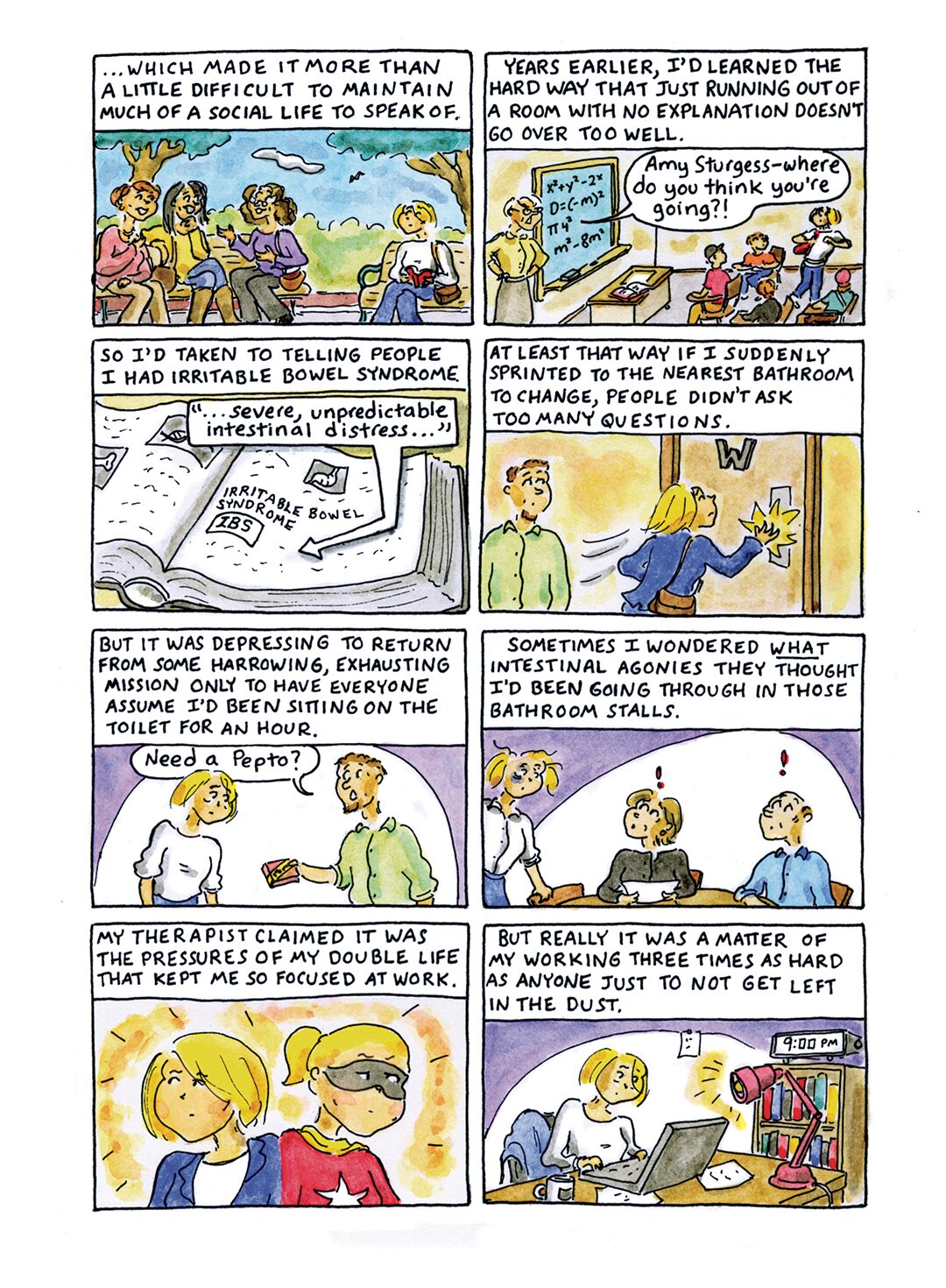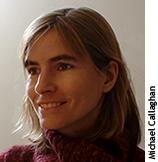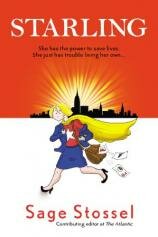Sage Stossel's Starling Takes Flight
Sage Stossel is a political cartoonist for the Atlantic, where she draws Sage, Ink. Her newest project is the graphic novel STARLING, from Penguin’s newly launched InkLit division. We caught up with Stossel to get some info on STARLING, her look at a modern-day superheroine dealing with some very funny realities in the middle of trying to save the world.
Tell us a little bit about Amy Sturgess, aka Starling. Where did the idea for this superheroine come from?
I had the overall premise for the story in mind --- of a superhero attempting to navigate regular life --- before I had a clear vision of who, exactly, the central character would be.
Then, as I was trying to think through how to work my way from general concept to specific story, a scene just sort of popped into my head, of a young woman griping to her therapist about the impossible demands of her superhero gig. I decided to try writing up that scene and see if it felt like I had anything there. And very quickly as I worked on it, a clear picture of Amy did emerge --- as a bit grouchy and not very self-aware, somewhat passive-aggressive in her tendency to procrastinate, and prone to ignoring directives…but, for all that, a better person (and superhero) than she gives herself credit for. By the time I'd finished the scene, I was very taken with Amy, and I knew I wanted to come up with a whole story for her.
One of the funniest running gags in STARLING is how, as one character notes, “she always kind of looks like she didn’t bother to brush her hair.” What made you want to create a superheroine who doesn’t have it all together and who struggles with looking like a regular person in a very glamorous industry?
Part of it was in keeping with my intention to make this a humorous take on what being a superhero would really be like, in contrast to the glamorous portrayals typically seen. (After all, considering that they lead secret double lives, I figure superheroes must be more --- not less --- harried and frazzled than the rest of us). It was also meant to reflect a bit on Amy's personality, as a no-nonsense person, very focused on her work, and on the fact that having been raised by neglectful cat-hoarders and treated like an outcast during her early schooling, her self-esteem is a bit shaky, and she's sort of at a loss for how to make herself look fancy or project pulled-together confidence.
Also, while in most ways Amy's not intended as any kind of proxy for me, and there's not a whole lot of resemblance between us, this is one characteristic I can confess to having borrowed from my own experience (as someone who's been known to accidentally leave the house wearing two different types of shoes and whose coworkers once told me they tried to put me on the show What Not to Wear). Since I knew from personal experience that there's humor to be had in less-than-competent self-presentation, I figured I might as well let Amy share the fun.
On a more serious note, after I'd written and mocked up a rough draft of the whole story and started googling around to try to figure out if there might be an audience for it, I started becoming aware of heated discussions going on in the comics world about how women are depicted in mainstream superhero comics. I'd given Amy a very basic, leotard-and-tights-type outfit for her Starling suit (almost like what you'd see gymnasts wear). But after becoming clued in to the phenomenon of female superhero characters being tarted up (and often deprived of their own perspectives and storylines) in a lot of comics, I went back and worked a scene into Amy's backstory where the vigilante organization she works for first tries to get her to wear a series of progressively slutty outfits, until she figures out that the organization's costume designer is in fact the director's 13-year-old son.

Although played for a lot of humor, the situations involved in the storyline of STARLING are in a way based on a “real” examination of what it would be like to be a superhero --- having to explain constant absences and keeping people at a distance so you can hide your secrets. Was this born out of a lot of examination of what it would really be like to be a superhero?
I was walking past Newbury Comics in Harvard Square one day, and I happened to notice that a significant proportion of the material in the window was superhero-related. Which got me thinking about the oddly persistent appeal of superheroes, given the fact that if you really think about it, the superhero life could be a pretty miserable one (since you'd be perpetually on call and not really getting any credit, since your identity would have to be secret). And that got me thinking that the interference of superherodom with a person's effort to build a satisfying life and career could be sort of an interesting concept to explore --- and one that might offer good fodder for some humor. So that was what really sparked the idea for the book.
It was from there that I started thinking through the logistics of what it would take to juggle regular life with the demands of being a masked vigilante. (It was also at that point that it occurred to me that claiming to have Irritable Bowel Syndrome, as Amy does, could be very handy cover for perpetually having to drop everything and run off to the nearest bathroom to change.)

The story is a long series of vignettes in the life of Starling. Did you write this in serialized installments, or was this always a long-form novel in your mind?
I always had this mapped out in my mind as a long-form novel. Not that I wanted it to come across as painstakingly engineered or anything, but in fact it very much was --- with certain events and details slipped unobtrusively (I hope) into particular scenes, which would only turn out to be important later on, and so forth. Since there were always a few storylines unfolding at once --- her make-or-break work project, the disappearance of her younger brother, her pursuit of her old almost-college-boyfriend, the ambiguous role of Matt --- I tried to find a good rhythm in switching back and forth among them, so that the moods and settings would be varied in a satisfying way. Given that my approach was to advance one part of the story with, say, a scene at her office, followed by a change-of-pace scene set elsewhere to advance another part of the story, it probably could also have worked as a publication in serial installments. But as I worked on it, I was always thinking of it as a whole.
The humor and the artistic style of STARLING are often in contrast with some of the serious issues raised in the story. What drew you to this contrast? Did it help define the story you were trying to tell?
It's true that STARLING has some dark themes. Amy's had a somewhat difficult life, and neither she nor her brother are particularly well adjusted (she's addicted to Xanax and living a lonely, harried existence; he's had troubles with harder drugs and has gotten mixed up with some bad elements). And a lot of the people Amy comes into contact with in the course of her superheroing are in desperate straits of some kind. (Throughout the book, she has a lot of empathy for the criminals she's supposed to be putting out of commission, since she's always felt like one of life's freaks and outcasts herself.)
Since so many of us cope with personal demons or loneliness or feelings of differentness of some kind, my hope is that the book's humor doesn't diminish the seriousness of that so much as defuse some of the darkness of it in a relatable way. (Having somewhat tormented, depressive tendencies myself, I've often looked to humor as a coping mechanism…which is kind of how I got into cartooning in the first place.)
As for the drawing style, I'm afraid I'm not a skilled enough artist to be able to claim I picked this particular way of rendering things from among many possible options. I just try to convey what's going on in the story as best I can and hope it comes across in a way that readers can follow and enjoy. (You might be right, though, that even if unintentionally my drawing style --- such as it is --- and penchant for warm, saturated colors probably do wind up working along with the humor to soften some of the book's darker themes.)
Are you a fan of traditional superhero comics?
I have to confess to having come at this from outside the world of traditional superhero fandom. Growing up, my older brother was an avid comics reader (Spider-Man, Daredevil, Avengers, The Dark Knight, and especially Watchmen), but I was more a reader of things like the Asterix books (which my brother also loved). With STARLING, the spark for the book was really a conceptual one --- that premise that popped into my head about the intersection of superherodom with everyday life --- rather than something that grew out of reading the genre. So there were some pretty basic superhero norms that (I'm embarrassed to say) I had to look up in order to try to make the story plausibly in keeping with that world. And despite my research, there are still things (like the cheesy-looking outfit I gave Starling) that probably give my ignorance away.
My hope is that my outsider status brings some fresh perspective to the genre and might draw interest from others who, like me, don't have deep preexisting knowledge of the superhero world. (At the very least, I hope my outsider take won't irritate true fans….)
What are some of your favorite graphic novel works?
A few years ago I discovered Posy Simmonds' reworkings of literary classics, which I love for their incisive social observations and their amazing pencil drawings. I also loved Charles Burns' Black Hole, which had me looking back over it for days afterwards, trying to make sense of what happened, and searching for messages and symbols that might or might not have been there. Like everyone else, I'm in awe of Alison Bechdel's Fun Home. And I've always loved the illustrated stories of James Thurber (though I know they don't strictly qualify as graphic novels).
The impetus for trying a graphic novel myself was that a year or so ago, an agent who'd seen my cartoons contacted me to inquire if I had any interest in doing one --- specifically, she suggested, a memoir "à la Alison Bechdel." A memoir wasn’t something I wanted to do at that point. But the agent's query did get me thinking that I'd love to try my hand at some kind of graphic novel. And it was around then that the train of thought set off by passing by the Newbury Comics display window sparked the idea for STARLING.
Since the concept was so different from what I knew the agent had in mind, when I was done working out the story, I set out to find an agent who would be excited about it for what it was, rather than half wishing it was something different. And I was very happy when an agent named David Hale Smith, who represents a lot of comics writers (including Greg Rucka, who's known for his strong female characters), expressed enthusiasm and said his daughter had absconded with the draft I'd sent and had been neglecting her homework as she read through to the end. He wound up placing it with Penguin, which was just launching its new graphic novel line, InkLit, under the direction of Rich Johnson, who became my editor. From that point it took a massive amount of manual labor to draw, ink, and color it for publication, but I loved working on it.
Will Starling return?
I would be thrilled if Starling is well enough received that there's a receptive audience for more installments. If that happens, I already have some ideas….








